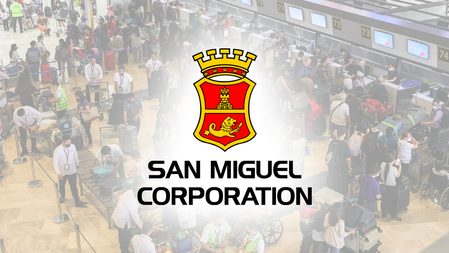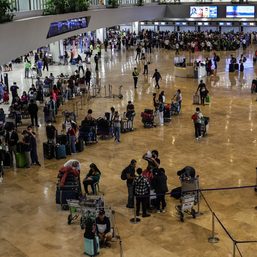SUMMARY
This is AI generated summarization, which may have errors. For context, always refer to the full article.

MANILA, Philippines – A consortium that includes San Miguel and South Korea’s Incheon International Airport Corporation has put up by far the highest bid amount for the lucrative contract to rehabilitate the Ninoy Aquino International Airport (NAIA).
Three groups, made up of some of the biggest Philippine conglomerates and international airport operators, went head-to-head in the last stage of the bidding for NAIA’s P170.6-billion privatization project. They were:
- Manila International Airport Consortium (MIAC) – Aboitiz InfraCapital, AC Infrastructure, Asia’s Emerging Dragon Corporation, Alliance Global-InfraCorp Development, Filinvest Development Corporation, JG Summit Infrastructure Holdings Corporation, and Global Infrastructure Partners
- GMR Airports Consortium – GMR Airports International, Cavitex Holdings, House of Investments
- SMC-SAP and Company Consortium – San Miguel Holdings, RMM Asian Logistics, RLW Aviation Development, Incheon International Airport Corporation
On Thursday, February 8, the Department of Transportation (DOTr) opened the financial proposals submitted by the three finalists. Government officials and consortium representatives crowded around padlocked and sealed boxes containing the financial bids. No in-person media coverage was allowed.
The security around the documents was tight because the bid amounts indicated there would likely determine the winner of the project. After all, Transportation Secretary Jaime Bautista said the amount of revenue that the bidder is willing to share with the government would be the “most important” factor in determining who wins.
So who came out on top? Here’s the breakdown:
- SMC-SAP and Company Consortium: 82.16%
- GMR Airports Consortium: 33.30%
- MIAC: 25.91%

San Miguel’s consortium offered the largest bid amount, which was more than triple that of MIAC. Essentially, this means that the consortium is willing to fork over 82.16% of their gross revenue, excluding passenger service charge revenue, to the government.
However, this doesn’t mean that the SMC-SAP consortium will win the project just yet as the DOTr is set to announce the winning bidder by Wednesday, February 14. The concession agreement will hand over the airport to the private sector for up to 25 years during which the operator is expected to upgrade its runways, four terminals, and other facilities. (READ: Bidding for NAIA rehab, privatization begins. Here’s what it covers.)
Even though the government has yet to announce an official winner, San Miguel has already sent out a press release announcing its “readiness to take on the modernization of the Ninoy Aquino International Airport.”
“Our aim is to elevate NAIA to world-class standard, ensuring an exceptional experience for all travelers with first-rate services and facilities. Our commitment is to ensure this project brings significant value and advantages to our nation, our government, and our kababayans (countrymen),” said Ramon Ang, president and chief executive officer of San Miguel.
Ang also praised the DOTr for its “transparent and equitable bidding process.”
Doesn’t San Miguel already own an airport?
It’s worth noting that San Miguel already owns an international airport: the New Manila International Airport set to rise in Bulacan. And soon, it could win the rights to operate NAIA too.
“Our vision is to create an integrated airport network that not only improves the travel experience but also supports sustainable economic growth and elevates the Philippines as a prime hub for tourism, business, and investment in the region,” Ang said in a statement.
The San Miguel tycoon said that being able to operate both airports will enable “potential synergies” and “enhance operational efficiencies, reduce costs, and optimize flight schedules.”
Interestingly enough, San Miguel nearly didn’t even make the cut for the bidding. Earlier in 2023, when the DOTr first conducted its pre-bidding conference for the NAIA project, Rappler reported how ownership limits stood in the way of San Miguel’s path to NAIA.
The bidding documents for NAIA state that a company that already operates an airport in Clark, Bulacan, or Cavite cannot be the sole private concessionaire of the airport. If they wish to bid for NAIA, they have to do so as part of a consortium in which their ownership stake is limited to just 20%.
An airport official told Rappler that the ownership restrictions were put into place to preserve competition.
However, the government eventually raised that ownership restriction to 33%, paving the way for San Miguel to form a consortium and join the bidding. San Miguel partnered with Incheon International Airport Corporation, along with two obscure companies: RMM Asian Logistics and RLW Aviation Development.
Online searches return no mentions of these two companies outside of the context of the NAIA project. In its press release, San Miguel did not mention them either, only highlighting its “strategic collaboration” with Incheon.
What happened to the competition?
San Miguel is known for making aggressive bids. For instance, in 2013, it also won the bid for the NAIA Expressway project after it beat out its lone rival Manila North Tollways Corporation, a Metro Pacific Investments subsidiary. San Miguel offered P11 billion in cash upfront – 36 times more than Manila North Tollways’ P305-million bid.
Prior to the emergence of San Miguel as a frontrunner for the airport, MIAC – a mega consortium made up of some of the country’s richest families – made plenty of noise about upgrading the airport. In June 2023, it bared a P267-billion unsolicited proposal to rehabilitate NAIA. However, the government ultimately thumbed this down and decided to go for a competitive bidding process.
Besides MIAC, the consortium led by GMR also made it far into the bidding process. GMR previously partnered with Megawide to develop the Mactan-Cebu International Airport. In 2020, it also made an unsuccessful offer to rehabilitate NAIA. In its current bid for the airport, GMR partnered with Cavitex Holdings and the Yuchengco Group’s House of Investments.
Meanwhile, the Asian Airport Consortium did not make it past the technical evaluation stage of the bidding. The consortium was made up of Lucio Co’s Cosco Capital, along with Asian Infrastructure and Management, Philippine Skylanders International, and PT Angkasa Pura. – Rappler.com
1 comment
How does this make you feel?






I appreciate the bidding process conducted by the Department of Transportation under the leadership of Transportation Secretary Jaime Bautista. But I have three queries: 1) Why was “in-person media coverage” not allowed? 2) What are the details about the “strategic collaboration” with Incheon? 3) Why is information about the “two obscure companies: RMM Asian Logistics and RLW Aviation Development” not given to the media?